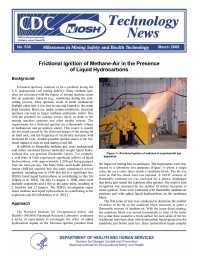Mining Publication: Technology News 530 - Frictional Ignition of Methane-Air in the Presence of Liquid Hydrocarbons
Original creation date: March 2008
Frictional ignitions continue to be a problem facing the U.S. underground coal mining industry. Many methane ignitions are associated with the impact of mining machine cutter bits on quartzitic material (e.g., sandstone) during the coal-cutting process. Most ignitions result in small methane-air fireballs often only a few feet in size and limited to the cutter head location. However, under certain conditions, frictional ignitions can lead to larger methane explosions and/or fires with the potential for causing serious injury or death to the mining machine operator and other nearby miners. Using a worn bit, five tests were conducted with only methane-air in the test chamber. The mixture did not ignite in any of the five tests, with an average of greater than 90 strikes per test. An additional five tests were conducted with added liquid hydrocarbon simulant on the sandstone. The methane-air mixture ignited in each of these five tests, with an average of about 30 strikes to ignition. The explanation may be that the liquid hydrocarbon ignites more easily than methane, and then it forms a pilot flame that ignites the methane. The hydrocarbon vapors can ignite at significantly lower temperatures than the methane. Based on these results, NIOSH researchers determined that the presence of a hydrocarbon liquid in the mining environment has the potential to increase the ignition hazard associated with the frictional heating from impact of steel on sandstone.
Authors: KL Cashdollar
Technology News - March 2008
NIOSHTIC2 Number: 20033470
Pittsburgh, PA: U.S. Department of Health and Human Services, Public Health Service, Centers for Disease Control and Prevention, National Institute for Occupational Safety and Health, DHHS (NIOSH) Publication No. 2008-124. Technology News 530, 2008 Mar; :1-2
See Also
- Are lithium-ion cells intrinsically safe?
- Degasification System Selection for U.S. Longwall Mines Using an Expert Classification System
- Frictional Ignitions in Underground Bituminous Coal Operations 1983-2005
- Ignition of Methane-Air Mixtures by Laser Heated Small Particles
- Laser Ignition of Flammable Gas
- Lasers
- Lightning Propagation Through the Earth and its Potential for Methane Ignitions in Abandoned Areas of Underground Coal Mines
- Methane-Air Mixtures Ignited by CW Laser-Heated Targets on Optical Fiber Tips: Comparison of Targets, Optical Fibers, and Ignition Delays
- NIOSH Research for Monitoring and Controlling Methane at U.S. Underground Coal Mining Operations
- Remote Methane Sensors
- Content source: National Institute for Occupational Safety and Health, Mining Program


 ShareCompartir
ShareCompartir
